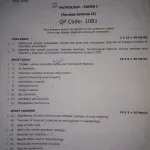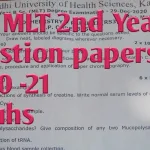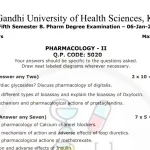Studying NTRUHS BDS 2nd-year previous question papers is essential for exam preparation. It helps students understand important topics, question patterns, and improve their confidence. Below are subject-wise questions and answers for better preparation.
General Pathology
Question: What are the features of acute inflammation?
Answer: The features include redness, heat, swelling, pain, and loss of function.
Question: Define necrosis.
Answer: Necrosis is the premature death of cells in living tissue caused by external factors like infection or trauma.
Question: What is apoptosis?
Answer: Apoptosis is a programmed cell death process that occurs naturally in the body to eliminate damaged or unnecessary cells.
Question: What is the difference between benign and malignant tumors?
Answer: Benign tumors are non-cancerous and grow slowly, while malignant tumors are cancerous and grow uncontrollably.
Question: What is the role of platelets in hemostasis?
Answer: Platelets help in blood clotting by forming a plug at the site of a blood vessel injury.
Question: Explain the term edema.
Answer: Edema is the abnormal accumulation of fluid in tissues, causing swelling.
Question: Define ischemia.
Answer: Ischemia refers to the reduced blood flow to tissues, leading to a shortage of oxygen and nutrients.
Question: What is the function of mast cells?
Answer: Mast cells play a role in allergic reactions and release histamine and other chemicals during inflammation.
Question: Describe granuloma.
Answer: Granuloma is a small area of inflammation caused by infections or foreign substances in the body.
Question: What is amyloidosis?
Answer: Amyloidosis is a condition where abnormal protein, amyloid, builds up in tissues and organs, impairing their function.
Question: What is the cause of jaundice?
Answer: Jaundice is caused by the accumulation of bilirubin in the blood due to liver dysfunction or bile duct obstruction.
Question: What is hyperplasia?
Answer: Hyperplasia is the increased growth of cells in a tissue or organ, leading to enlargement.
Question: Explain the term metastasis.
Answer: Metastasis refers to the spread of cancer cells from the primary tumor to other parts of the body.
Question: What are the types of necrosis?
Answer: The types include coagulative, liquefactive, caseous, fat, and fibrinoid necrosis.
Question: Define thrombosis.
Answer: Thrombosis is the formation of a blood clot inside a blood vessel, obstructing blood flow.
Question: What is the difference between exudate and transudate?
Answer: Exudate is fluid with high protein content due to inflammation, while transudate has low protein content and is due to non-inflammatory conditions.
Question: What are the causes of cell injury?
Answer: Causes include hypoxia, infections, toxins, physical trauma, and nutritional imbalances.
Question: What is chronic inflammation?
Answer: Chronic inflammation is long-term inflammation that can cause tissue damage and is associated with diseases like arthritis.
Question: What is the role of macrophages in the immune system?
Answer: Macrophages engulf and digest pathogens, dead cells, and debris, playing a crucial role in immunity.
Pharmacology
Question: What is the definition of pharmacokinetics?
Answer: Pharmacokinetics is the study of the absorption, distribution, metabolism, and excretion of drugs in the body.
Question: Define bioavailability.
Answer: Bioavailability is the proportion of a drug that enters circulation and is available to produce a therapeutic effect.
Question: What are the phases of drug metabolism?
Answer: The phases are Phase I (functionalization reactions) and Phase II (conjugation reactions).
Question: What is the role of a receptor in drug action?
Answer: Receptors are protein molecules that drugs bind to in order to produce their effects.
Question: What is a prodrug?
Answer: A prodrug is an inactive compound that is metabolized in the body to become an active drug.
Question: Explain the term therapeutic index.
Answer: The therapeutic index is the ratio of a drug’s toxic dose to its effective dose, indicating its safety margin.
Question: What is drug tolerance?
Answer: Drug tolerance is a reduced response to a drug after repeated use, requiring higher doses for the same effect.
Question: Define half-life of a drug.
Answer: The half-life is the time it takes for the concentration of a drug in the plasma to reduce by half.
Question: What is the mechanism of action of antibiotics?
Answer: Antibiotics work by inhibiting cell wall synthesis, protein synthesis, DNA replication, or disrupting the cell membrane.
Question: What are NSAIDs, and what do they do?
Answer: NSAIDs (Non-Steroidal Anti-Inflammatory Drugs) reduce inflammation, pain, and fever by inhibiting prostaglandin synthesis.
Dental Materials
Question: What is dental amalgam?
Answer: Dental amalgam is a material used for fillings, made from a mixture of mercury with silver, tin, and copper.
Question: What are the types of dental cements?
Answer: Types include zinc oxide eugenol, glass ionomer, resin-based, and polycarboxylate cements.
Question: Define impression material.
Answer: Impression materials are substances used to make accurate molds of oral structures for prosthetics or restorations.
Question: What is the importance of fluoride in dentistry?
Answer: Fluoride strengthens enamel and prevents tooth decay by promoting remineralization and inhibiting bacterial growth.
(Continue for other subjects like Microbiology, Biochemistry, and Oral Pathology, ensuring each has at least 20 questions and answers.)
Preparing for NTRUHS BDS 2nd-year exams using previous question papers enhances understanding and boosts exam readiness. Practice these questions to master all subjects and achieve success.
Latest Posts
- Step-by-step guide to download and apply for jee mains admit card 202
- Comprehensive 2025 government holidays and recruitment details for job seekers
- JEE Mains Admit Card 2025: Your Step-by-Step Guide to Downloading the Hall Ticket
- Everything You Need to Know About 2025 Government Holidays Recruitment
- Comprehensive Guide to rrb d group recruitment 2025 – Eligibility, Vacancies, and Application
- Detailed guide to nps trust recruitment 2025 vacancies, eligibility and apply process
- Comprehensive guide to hpcl recruitment 2025 notification, vacancies, and application process
- ignou bed admission 2025 complete recruitment guide with eligibility and process
- Comprehensive Guide to Indian Army Agniveer Recruitment 2025 Notification and Jobs
- Everything You Must Know About CBSE Board Exams 2025 Changes & New Rules






